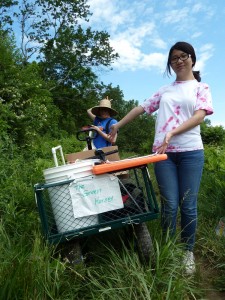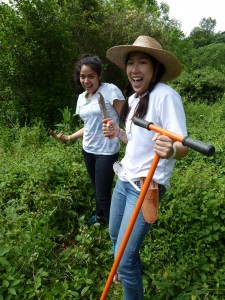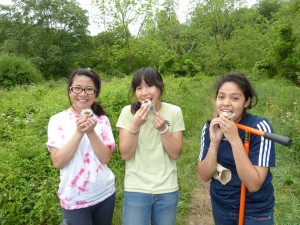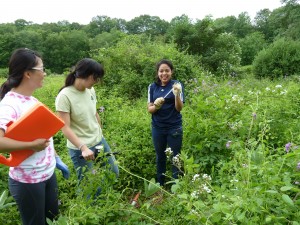Episode Title: The Funnel Mystery
Episode number: Season one, episode three
Air Date: July 2, 2013
The third and final episode for season one of The League of the Green Hornet “The Funnel Mystery” has been in production for several weeks and has had many set-backs. It is currently under its third re-shooting under the supervision of Dr. Molly Jacobs and Dr. Brett McMillan. The plot is to explore if soil compaction acts as a barrier for soil invertebrates in a lab setting and to see if different organisms come out of the soil at different times.
The setting of this episode is the Ecology lab where gathered soil from the field was put into different funnels containing varying levels of soil compaction. Each funnel had wire mesh at the bottom to hold the soil inside and the funnels were placed on containers with ethanol. They were left under lights for 5 days to force the organisms to crawl away from the heat and disappearing moisture into the ethanol for preservation and later microscope identification by the patient Detectives. Every jar was collected at intervals to track the movement of the invertebrates through the soil layer.
In the first attempted 4” PVP pipes were filled with a 1 inch layer of top soil and then compacted or left non-compacted. Then the freshly gathered soil from the field was added and the set up placed under lights. Very few organisms were found so a new setup had to be found. Detective Xi suggested using metal funnels since the PVP did not seem to get as hot as the metal.
In the second attempt metal funnels were used and this time the experiment was expanded. The different conditions were 1 inch compacted and non-compacted (4 each) and 2 inch compacted and non-compacted (3 each) for a total of 14 samples. Many hours of waiting and looking through empty jars showed once again very few organisms and no clear pattern of invertebrate densities (Detective Mary was looking for more organisms in the control and few if any in the experimental).
The current set up suggested by Supervisor Molly is still partially experimental. First the layers have been reduced to ½ inch for both the compacted and non-compacted layer. As a second modification the layers are made up with either sterile, rehydrated soil from the previous 2 attempts or soil from the freshly gathered soil that will be used as a sample. These modifications are based on the hypothesis that the topsoil is too different for the organisms to want to go through and that even a 1 inch layer may be too tick for the them. Hopefully this set up will meet the standards of the target audience. The audience includes cute fellows like the cute springtails
.Fun Fact: Spring tails can “jump” up to 15 cm which for humans would be like jumping over a skyscraper!
Photo from the North Carolina State University http://www.cals.ncsu.edu/course/ent525/soil/soilpix/index.html

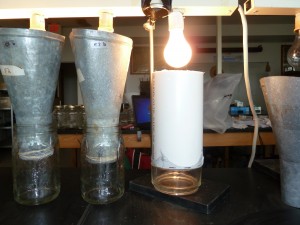
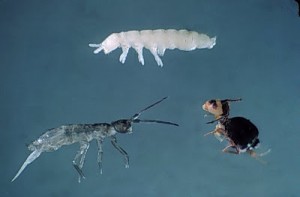
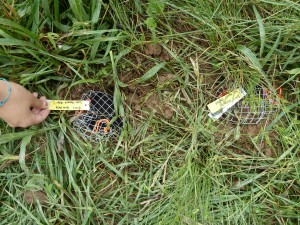 A total of 48 mesh traps were buried 3 inches in the soil in 6 different sites. There are two locations per site, one near the path and one away from the path. The near the path and away from the path mesh traps are filled with topsoil. Every sample has its own control mesh trap filled with regular soil. The purpose of the Soil re-colonization experiment is to determine the rate of re-colonization of invertebrates near the path and away from the path in order to verify if the path serves as a barrier for soil invertebrates. We hypothesize that the samples near the trail will have slower rate of re-colonization due to the disturbance of the path used by humans and horses. An early harvest will be collected in 5 days (Wed. 19 ) to determine the rate of re-colonization. A late harvest will be collected in 11 days (Mon. 24).
A total of 48 mesh traps were buried 3 inches in the soil in 6 different sites. There are two locations per site, one near the path and one away from the path. The near the path and away from the path mesh traps are filled with topsoil. Every sample has its own control mesh trap filled with regular soil. The purpose of the Soil re-colonization experiment is to determine the rate of re-colonization of invertebrates near the path and away from the path in order to verify if the path serves as a barrier for soil invertebrates. We hypothesize that the samples near the trail will have slower rate of re-colonization due to the disturbance of the path used by humans and horses. An early harvest will be collected in 5 days (Wed. 19 ) to determine the rate of re-colonization. A late harvest will be collected in 11 days (Mon. 24).